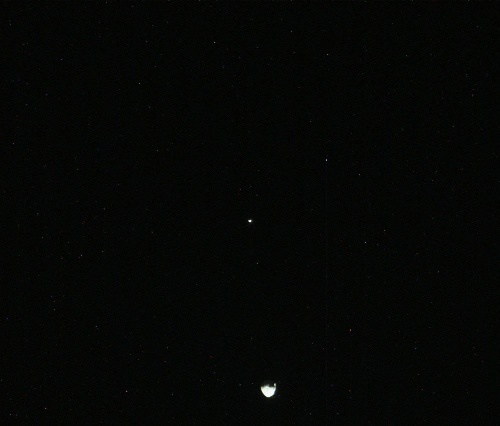Sol 351 for the Curiosity rover on Mars was a marvelous night for a moon dance. The Mars Science Laboratory rover caught sight of Mars’ two moons, Phobos and Deimos together in the sky. And not just one image was captured: the rover’s Mast Camera captured a series of 41 images to allow the MSL team to create this timelapse movie of the dance, where the smaller moon Diemos is occulted by Phobos.
To our knowledge, this the first time the two moons have been seen together in any image from the surface of Mars, let alone a sequence of images. The Mars Express spacecraft took images of the moons together in 2009 from orbit.
The movie from MSL takes just a few seconds to watch, but the team said the real time it took to shoot the 41 images was 55 seconds.
Sol 351 equates to August 1, 2013 here on Earth.
See a raw still shot below:
Update: JPL has now put out a press release about the movie, confirming that no previous images from missions on the surface has caught one moon eclipsing the other.
They also said there was a slight delay in getting these images from the rover, as there were higher-priority images in the queue that were to be used for planning the rover’s drives.
Scientists know that the orbit of Phobos is very slowly getting closer to Mars, while the orbit of Deimos may be slowly getting farther from the planet. These observations of Phobos and Deimos help researchers make knowledge of the moons’ orbits even more precise.
“The ultimate goal is to improve orbit knowledge enough that we can improve the measurement of the tides Phobos raises on the Martian solid surface, giving knowledge of the Martian interior,” said Mark Lemmon of Texas A&M University, College Station, a co-investigator for use of Curiosity’s Mastcam. “We may also get data good enough to detect density variations within Phobos and to determine if Deimos’ orbit is systematically changing.”
There’s also this nice graphic comparing our Moon to Phobos and Deimos:

Although Phobos has a diameter less than one percent the diameter of Earth’s Moon, Phobos also orbits much closer to Mars than our moon’s distance from Earth. As seen from the surface of Mars, Phobos looks about half as wide as what Earth’s moon looks like to viewers on Earth.
Nice work Curiosity and team!


Some fantastic images of these two moons Nancy, but I have seen other imagery from the Spirit rover that show both Phobos and Deimos in the same frame:
http://commons.wikimedia.org/wiki/File:Phobos_%26_Deimos_full.gif
http://earthsky.org/space/phobos-and-deimos
Thank you! I’ve wondered about that (the relative sizes) all my life. Fantabulous!